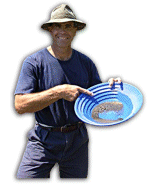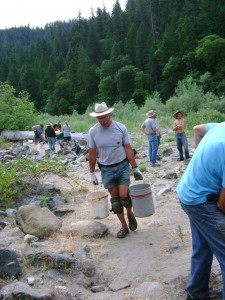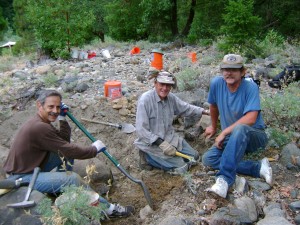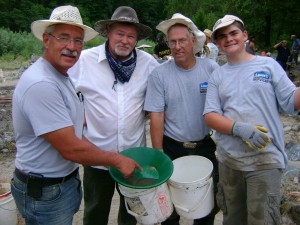
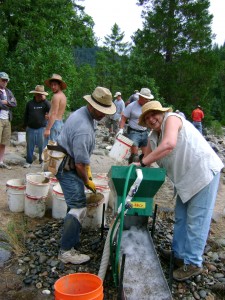
Successful gold mining on any scale must be accomplished in two separate steps. The first is prospecting. We also call this “sampling.” We sample to try and find a high-grade deposit. The idea is to not invest very much of your time into any given location until you find something that is going to pay off. Once we find a good location through sampling, we switch gears into what we like to call “production.” During the production phase, we try and process as much of the high-grade material as possible given our rather limited resources.
Nearly the entire focus of our Weekend Group Projects is on these two phases. And it was no different on this particular project. After reviewing the theory Saturday morning using a backboard demonstration, all 48 of us met after lunch out at our famous K-15A property, otherwise known as the “Mega-hole.” While the theory is important, nothing can compare to actually doing it out along the river with experienced prospectors.
Once out on the river, the first thing we always do is provide a substantial demonstration on how to take a proper sample. Sampling is not just about shoveling some streambed material in your pan. You have to focus on gathering up targeted material. Since we know that the gold on K-15A is concentrated directly on top of a special brown layer which is about a foot deep in the streambed, the best sample will be from filling our gold pan with that particular material. We do this by first shoveling aside the material which is on top. Once we get down to the target area, we carefully gather up the material which is in the contact zone between the two different layers.
Then we pan that material very carefully. We need to be careful, because the sample is so small. We cannot afford to lose a single speck of gold if we want to have an accurate look at how much gold is in the contact zone. Sometimes a sample pan will just turn up a few specks. Seeing those specks might prompt you to take a few more samples. Then one of those additional samples might show a better result. The better result might prompt you to process 25 or 50 buckets of the target material through your high-banker to see how good the area really is. This is how high-grade deposits are found.
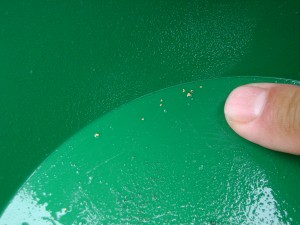
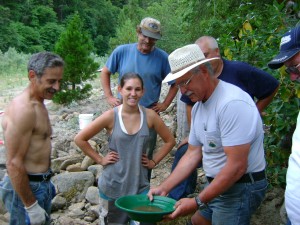
After providing this group with a sampling and panning demonstration, we passed the pan around to show how much gold we recovered. It was better than an average result. Doing this provides newcomers a baseline in two important ways:
1) They can compare how much gold they get in their own pan samples to what they saw me recover. Then they have an idea if they are getting an acceptable result.
2) They will be able to compare how much gold we get in our single sample pans to the amount of gold we recover when processing the same material in volume on the following day. Tying the sample result to the production result gives a prospector judgment in what he or she is looking for during prospecting.
After seeing my result, this enthusiastic group spread out across the bar and started doing their own pan samples. Thankfully, I had eight experienced members helping me with this particular project. While half of them were helping beginners with their panning techniques, the others set up our high-bankers for the following day. A “high-banker” is a gold recovery system which can be set up some distance from the waterway, which will process much more volume than a gold pan. This means pay-dirt does not have to be carried very far, or can actually be shoveled directly into the high-banker.
About half of the participants in this project were beginners. So my helpers and I stayed out on the bar on Saturday afternoon until everyone out there was panning correctly. Since many were recovering their first gold, which was theirs to keep, there were still plenty of people going hard at it when we departed.
Saturday night potluck at the Grange Hall in Happy Camp lured in most of the participants, along with plenty of other members who either live in the area or were doing their own mining programs. There was more food to go around than we needed, and morale was very high – which always makes me happy. We had a short meeting and ended with a prize drawing. These weekly potlucks have been a New 49’er tradition during our busy months all the way back to our first season in 1986.
We were shifting over into a production mode on Sunday. So my helpers put their “Team Leader” hats on and split the whole bunch of people down into smaller, more efficient groups. We started early, about 7 o’clock, so we could get most of the hard work done before the worst heat of the day was upon us.
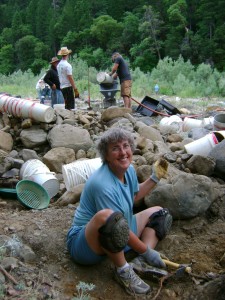
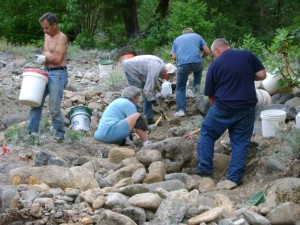
All of the gold we recover on Sunday goes into a common bucket. Everybody who helps will get an equal share at the end of the day. The production focus on Sunday switches to volume of the target material. We want to fill buckets with as much pay-dirt as we can, and process it through the high-bankers. Having said this, there are three important points that we stress:
1) Processing volume is most-effectively accomplished by reaching way out and dragging a bunch of material into the hole. We call this a “top cut.” Once in the hole, it is easy to remove oversized rocks from the loose material and shovel the remainder into buckets. Then we do the same thing again with a “mid cut.” The wider you are making the top cut, the easier it is to take apart the puzzle of rocks that are wedged together. This method is much faster than just working one rock loose at a time, a practice we refer to as “nitpicking.” Here are some demonstrations from me of how to use a hand-pick to get optimum results:
2) It is important to not fill the buckets with low-grade material. By this, I mean loose sand or gravel on the surface seldom have enough gold to justify being processed through a high-banker. But because beginners want to feel productive, sometimes we really have to impress upon them to stop filling buckets with non-producing material. Since we will be feeding the high-bankers at full capacity, every bucket of worthless material will subtract from a bucket of pay-dirt. This will directly affect how much gold we will recover at the end of the day. The same principle applies to the material which is below the contact zone. The amount of gold we will recover is directly related to how much of the target material that we process. Here is Ray Derrick’s explanation of the way we like to do it:
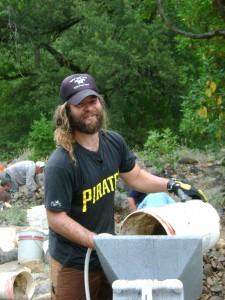
3) To get the most out of a high-banker recovery system, you must supply it with a steady feed. Dumping a whole bucket in there at once will overwhelm the system, and some of your gold will wash right out into the tailings. You can tell where maximum capacity is by watching to make sure the riffles do not get overwhelmed and pack up. Here follows Richard Krimm’s explanation of the proper way to feed a recovery system:
We normally do not break for lunch on Sunday. It is understood that everyone will take breaks whenever they need them. Otherwise, we just try to keep the high-bankers running. When they run out of fuel, it gives us an opportunity to clean out a front portion of the recovery system from one of the high-bankers. We work this down in a pan and show the gold around to all the participants. This goes a long way to convince everyone that their effort is adding up to something good. It also always motivates another 150 or 200 buckets of pay-dirt after we refuel. The following video segment captured the mid-day look at how we were doing:
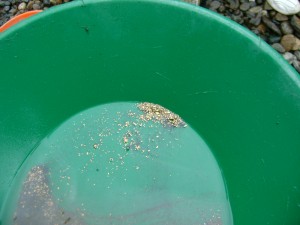 It starts getting pretty hot out on the bar by about noon. So that’s normally about the time we are shutting things down and going into our final clean-up stages. By “clean-up,” I mean removing the gold and other heavy concentrated material, mostly iron, from the recovery system, and going through a step-by-step process to reduce it all the way down to just the gold. We begin this process out on the bar; but the final part, and the gold split is completed in Happy Camp.
It starts getting pretty hot out on the bar by about noon. So that’s normally about the time we are shutting things down and going into our final clean-up stages. By “clean-up,” I mean removing the gold and other heavy concentrated material, mostly iron, from the recovery system, and going through a step-by-step process to reduce it all the way down to just the gold. We begin this process out on the bar; but the final part, and the gold split is completed in Happy Camp.
The main purpose of these Weekend Projects is to expose our members to all of the essential parts of a successful small-scale gold mining program. It begins with sampling. Then it switches to production. And then we go through the final clean-up, separation, weighing and gold split. All participants are invited to participate in every step.
In all, we recovered 285.5 grains of beautiful gold. That’s about 6/10ths of an ounce, or about $1000 at today’s gold value. Not too bad for less than four hours of production work. There were also 23 natural gold nuggets. There were a lot of smiling faces as we split the gold evenly amongst the participants.
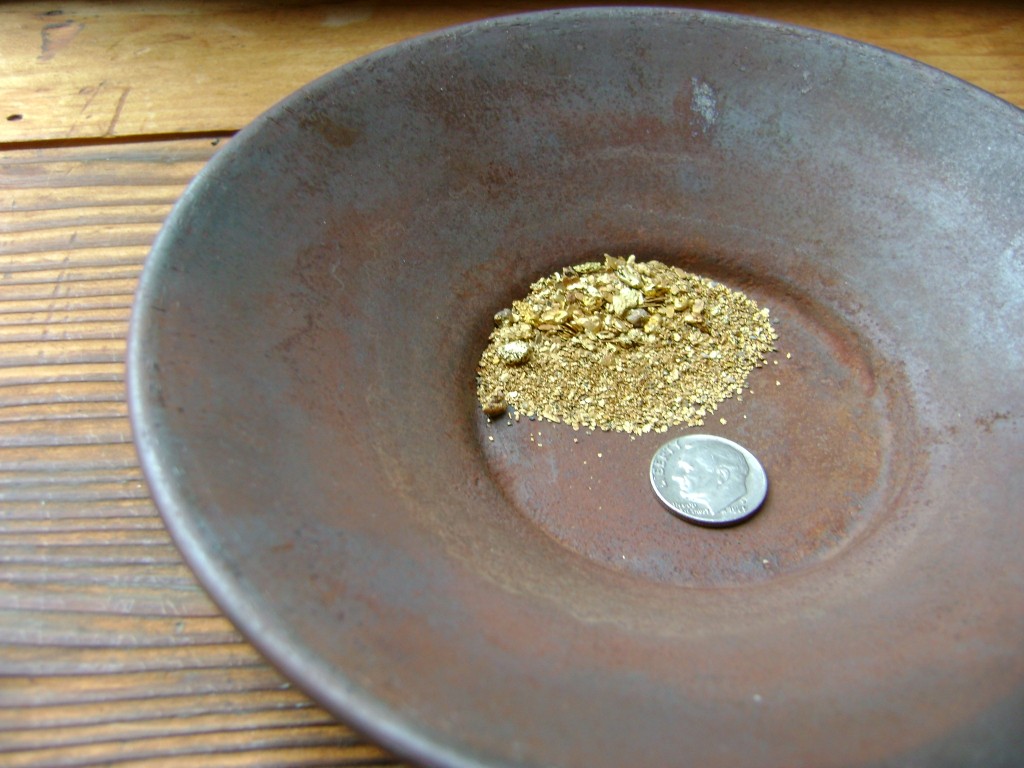
High-banking in California this Season
While Oregon is more user-friendly towards suction dredging; our best high-banking opportunities remain along our extensive properties on the Klamath River in northern California. Therefore, Our Weekend Group Mining Projects will take place during 2012 near our headquarters in Happy Camp. They are scheduled as follows: June 2 & 3; June 23 & 24; July 14 & 15; August 4 & 5; August 25 & 26. These events are free to all active Members, and everyone is invited to attend. Please contact our office in advance to let us know you will be there: (530) 493-2012.
New Legal Fund Prize Drawing
On behalf of The New 49’ers and some individual members, our attorney filed a legal challenge to California’s new dredge regulations last month in concert with a “takings” claim against the State of California. If we cannot overcome the incredibly-restrictive regulations, then we will force the State to buy all of the mining properties which have been rendered valueless. Defending the rights of small-scale miners, this now places us in three separate litigations, in three separate jurisdictions. Since costs are mounting, we greatly appreciate your participation in our legal fund drawings!!
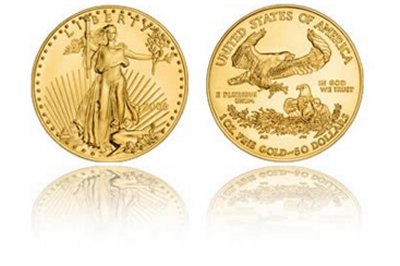
We will be giving away 15 prizes in our new legal-fund raiser:
Grand Prize: 1-ounce American Gold Eagle
Four ¼-ounce American Gold Eagles
Ten 1/10th-ounce American Gold Eagles
The drawing will take place at our weekly potluck in Happy Camp on Saturday, 7 July (2012).
The girls in our office automatically generate a ticket in your name for every $10 legal contribution that we receive ($100 would generate 10 tickets, etc). There is no limit to the size or frequency of your contributions, or to the number of prizes you can win. Contributions can be called in to our office at (530) 493-2012, or they can be mailed to The New 49’ers, P.O. Box47, Happy Camp, CA 96039. Or you can do it on our web site by going here: Make a Donation
2012 Group Insurance Policy
All Members are eligible to sign up for $10,000 of accidental medical Insurance which covers you while camping, prospecting for gold, and also during any activities which we sponsor. Dental accidents are included, along with $2,500 for accidental death or dismemberment. The policy has a $100 deductable. It is an annual policy which extends through January of 2013. This insurance is available for $30 per year, per person. More information can be found here.
Sign up for the Free Internet Version of this Newsletter: We strongly encourage you to sign up for the free on line version of this newsletter. The Internet version is better, because you can immediately click directly to many of the subjects which we discuss; because the on line version is in full color; because we link you directly to locations through GPS and Google Earth technology; and because you can watch the free video segments which we incorporate into our stories.
The New 49’ers Prospecting Association, 27 Davis Road, Happy Camp, California 96039 (530) 493-2012
www.goldgold.com



